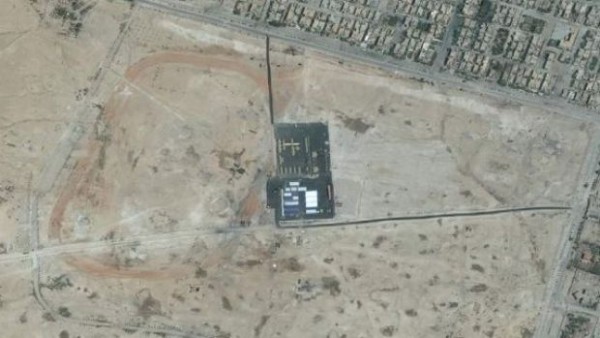PHOTO: A Russian officer oversees a demining operation near Palmyra
Russia’s Defense Ministry has denied that its growing military position near Palmyra in central Syria is a “base”.
The Ministry’s spokesman, General Igor Konashenkov, said the position — whose development has been seen on satellite images — is “only a temporary camp” for mine-clearing personnel.
On May 7, AFP released video of the area, just west of the Roman-era city which was recaptured by pro-Assad forces from the Islamic State in late March. It included a high fence topped with razor wire, prefabricated container buildings, large tents for equipment maintenance, a field kitchen, satellite communications dishes. and a sophisticated anti-aircraft system. At least six armored personnel carriers were present, suggesting deployment of a Russian combat unit.
A pro-regime outlet declared that the Russians were constructing “a military base to use as an ‘operation room’ to target terror groups”.
Russia also has positioned attack helicopters at the al-Shayrat and Tiyas (T-4) airbases near Palmyra. Video footage has shown aerial operations against the Islamic State, which has been threatening the T-4 base this month.
On Tuesday, mainstream media caught up with the story after the release of satellite imagery of the camp, which is just north of Palmyra’s Roman ruins.

(Photo: ASOR/DigiGlobe)
Maamoun Abdulkarim, the head of Syria’s Antiquities and Museums Department, said the Russians have built a “small barracks” that includes offices and clinics. He said he would not have allowed the development on the historic site if he had been asked:
We refuse to give permission even if it was for a small room to be built inside the site — whether it is for the Syrian army, Russian army or anyone else. We will never give such permission because this will be in violation of the archaeology law.
Abdulkarim continued, “During the time of war, sometimes archaeological authorities don’t have a say but security decisions dictate the orders. Once the situation improves and peace is reached, then we will openly call for removing [the camp].”
An official with the UN cultural organization UNESCO said that if the encampment is close to the Roman ruins, it will contravene the 1954 Hague Convention for the Protection of Cultural Property in the Event of Armed Conflict.
“We’re going to look at the satellite pictures to see if it is inside the buffer zone,” the official said.
UNESCO’s media office said the agency is “still in the process of establishing and verifying the facts on the ground”.
Russia’s Konashenkov insisted that the camp was only for demining experts, whom he said have defused about 18,000 explosives since Palmyra was recaptured.
He denied that Moscow had acted without permission, “The deployment of the temporary camp until the end of the mine clearing effort has been agreed with the Culture Ministry and other state institutions of the Syrian Arab Republic” He said that the field hospital treated local residents and a field bakery’s “products are also handed out to Syrians”.
However, a pro-regime activist with links to the Syrian military continues to write of Russian military “advisors”, whom he says are essential to the Assad forces in central Syria.
The only reason the Syrian Army hasn't lost Palmyra by now is due to the Russians. The Russian military advisers are a godsend to the SAA.
— Leith Abou Fadel (@leithfadel) May 18, 2016
Russia’s main base has been the Hmeimem airbase in Latakia Province in western Syria, supporting the start of Moscow’s aerial intervention last September. However, as Moscow’s bombings and deployment of advisors have expanded, new positions have been established in the center and northeast of the country. These have included ground operations in Hama Province and deployments at an airbase near Qamishli, close to the Turkish and Iraqi borders.

